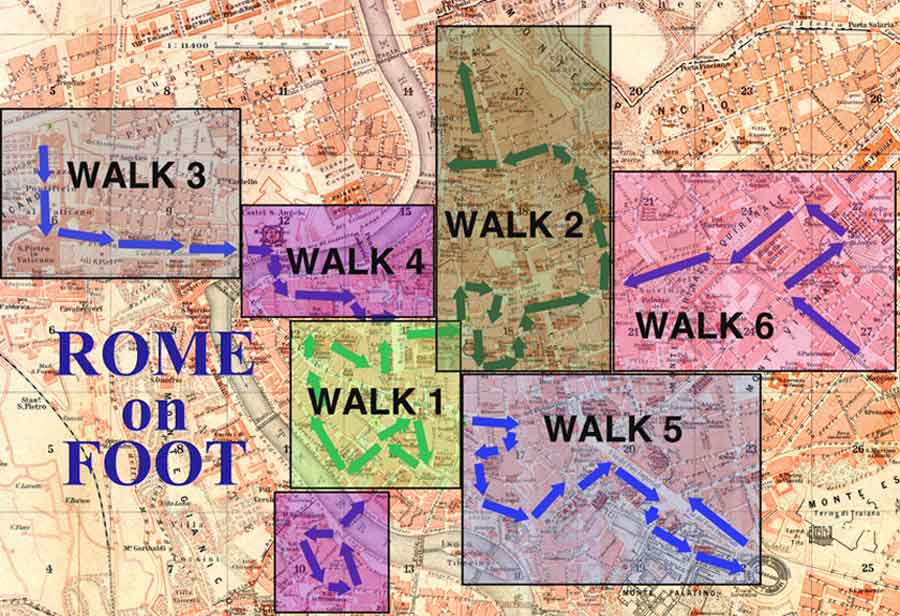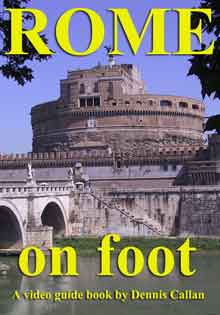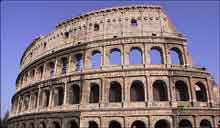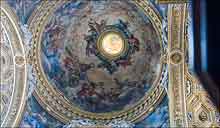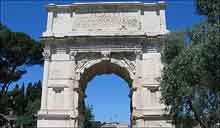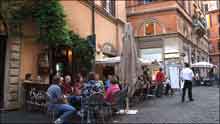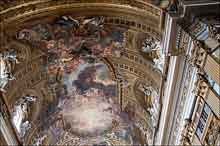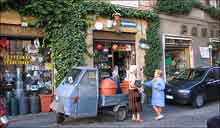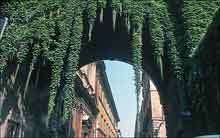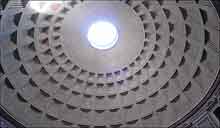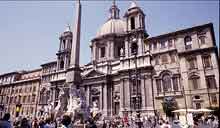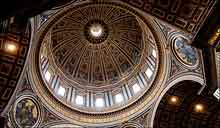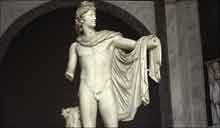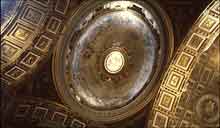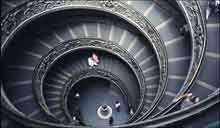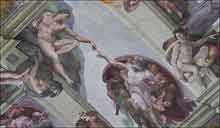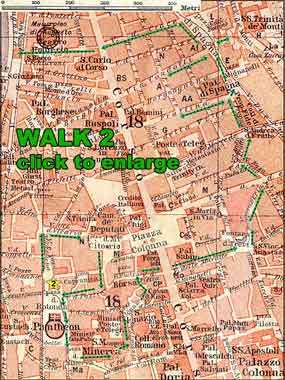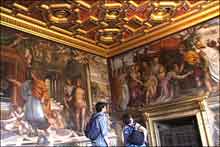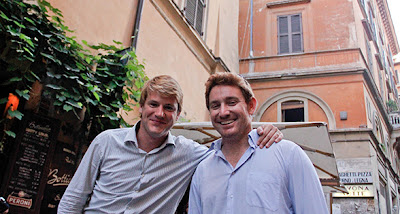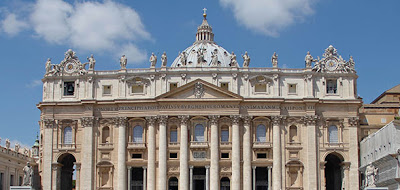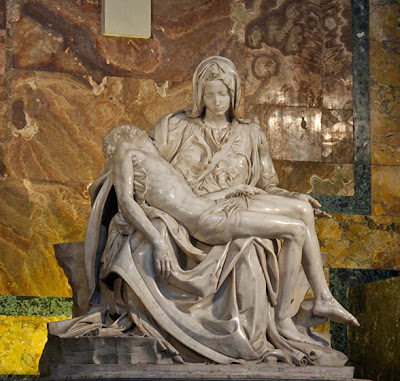General information regarding Ostia Antica's excavations
For
additional information regarding the archeological site, you are
pleased to contact directly the 'Soprintendenza' and the ticket office,
you'll find their contacts at the bottom of this page. But please, make
sure to read this page before doing that, you'll probably find the
answers to most of your questions.
The best period to visit the
excavations is surely the spring, from half March till the end of May.
Another good period would be from the end of September to the beggining
of November (weather allowing).
Ostia Antica's excavations timetable
Closed every Monday and in the 1st of January, 1st of May and on the 25th of December.
January and February, November and December:
08.30 - 16.00 (public exit within 17.00)
March:
08.30 - 17.00 (public exit within 18.00)
From the Daylight saving time beginning (last Sunday of March) till October:
08.30 - 18.00 (public exit within 19.00)
From the last Sunday of October (end of Daylight saving time) till the 1st of November:
08.30 - 17.00 (public exit within 18.00)
Tickets information--Ticket € 8,00--Reduced ticket € 4,00
How to reach the archaeological site
The address of the excavations is:
Scavi di Ostia - Via dei Romagnoli, 717 - 00119 Ostia Antica - Roma
By
car you need to follow the signs to Ostia Antica, the excavations are
along the main street (Via dei Romagnoli). You won't have problems
finding them.
By metro if you are in the middle of Rome, for
example at Termini, you need to take the line B direction Laurentina
till Magliana (will take around 7 minutes) and from Magliana take the
metro to Lido di Ostia till at Ostia Antica (will take around 20
minutes). As soon you are out of the station you'll see a blue foot
bridge in front of you, cross it and keep going straight till you'll
reach a fountain, cross the road in front of it and again keep going
straight till the gate of the excavations (less then 2 minutes).
Other
useful information-- It's possible to reserve a guided tour from
Tuesday to Sunday contacting the ticket office. It's possible to have
an audio guide in Italian, English and French, ask at the ticket
office. It's not allowed the access to the excavations with
transportation which can stop at the checked parking (paying) close to
the ticket office.
Within the excavations, right beside the Ostiense Museum and the offices, there's a cafe, restaurant and a bookshop.

The
Roman port of Ostia is easier to visit than Pompeii (which is four
hours south of Rome by train). And, in some ways, it's more interesting.
Because Ostia was a working port town, it shows a more complete and
gritty look at Roman life than wealthy Pompeii. Wandering around
today, you'll see the remains of the docks, warehouses, apartment
flats, mansions, shopping arcades, and baths that served a
once-thriving port of 60,000 people.
Getting to Ostia
Getting to Ostia Antica from downtown Rome is a
snap — it's a 45-minute combination Metro/train ride to Ostia Antica.
It'll cost you just one Metro ticket each way. From Rome, take Metro
line B to the Piramide stop (which really
is next to a pyramid,
and several other interesting sights — it's worth a quick stop). The
Piramide Metro stop is also the Roma Porta San Paolo train station, so
the train tracks are just a few steps from the Metro tracks — follow
signs to
Lido. All trains depart in the direction of Lido, leave
every 15 minutes, and stop at Ostia Antica along the way. The lighted
schedule at each track will read something like,
"Treno in partenza alle ore 13.25," meaning,
"Train departing at 13:25." Look for the train departing next, hop on,
ride for about 30 minutes (keep your Metro ticket handy), and get off at
the Ostia Antica stop. (If you don't have a ticket to get back,
purchase one at the ticket window at the station, or from the nearby
snack bar.)
Leaving the train station in Ostia Antica, cross the
road via the blue sky-bridge and walk straight down Via della Stazione
di Ostia Antica, continuing straight until you reach the parking lot.
The entrance is to your left.

History
Located at (and named for) the mouth (ostium) of the
Tiber, Ostia was founded about 620 B.C. Its main attraction was the salt
gleaned from nearby salt flats, which was a precious preserver of meat
in ancient times. Later, as Rome began expanding (around 400 B.C.),
Ostia was conquered, and a fort, or castrum, was built here. Ostia —
often called Rome's first colony — served as a naval base, protecting
Rome from any invasion by river. By A.D. 150, when Rome controlled the
Mediterranean, Ostia's importance became commercial rather than
military. Rome eventually outgrew the port of Ostia, and a vast new port
was dug nearby (where Rome's airport now stands). But Ostia remained a
key administrative and warehousing center, busy with the big business of
keeping more than a million Romans fed and in sandals. With the fall of
Rome, the port was abandoned. Over time, the harbor silted up, and the
Tiber retreated to about one mile away. The mud that eventually buried
Ostia actually protected it from the ravages of time — and
stone-scavenging medieval peasants.
Ostia Antica Tour

Consider your visit a three-part affair:
1.
Follow this tour, which leads you straight down Decumanus Maximus (the
town's main drag), with a couple of slight detours, finishing at the
forum (the main square).
2. Pop into the museum and consider getting a bite to eat at the cafeteria.
3. Explore the back lanes — going on a visual scavenger hunt — as you wander your way back to the entry point.
1. Cemetery (Necropolis):
Find the map (30 yards inside the gate) for an orientation. Notice
how the core of Ostia is a rectangular Roman military camp with two
major roads crossing at the forum. One of four city gates lies
ahead, and on your left is the
necropolis (cemetery). Ancient
Romans buried their dead outside the city walls. Detour to find family
sepulchres — private open-air rooms lined with niches for
ash-filled urns. Until the first century A.D., cremation was common.
In the second and third centuries A.D., the Romans here buried
their dead in marble and terra-cotta sarcophagi in tombs.
2. Porta Romana: Ahead
(where the road gets narrow) you enter the ancient city of Ostia
through the scant remains of the gate Porta Romana. Just as Rome's
Porta Ostiense faced Ostia, Ostia's Porta Romana faced Rome. Just
inside to the left (under the big tree), you can see on the gate the
bits of the Latin inscription that greeted all who entered. It
reads: "The Senate and the people of the colony of Ostia constructed
the walls." The "colony" reference is a reminder that Ostia was the
first bit of the Roman Empire.
From the gate, Ostia's main street
(named Decumanus Maximus) leads straight to the Forum, where this
walk ends. Note that this road was elevated above some buildings'
foundations. Over the centuries, Ostia's ground-level rose. You can
actually identify buildings from the Republic (centuries before
Christ) and the empire (centuries after Christ) by their level.
Anything you walk down into is from the earlier period.
3. Republican Warehouses (Magazzini Repubblicani):
The first century B.C. was busy with activities relating to the
river port. Walking along the main street you pass vast warehouses
on the right. The goods of the port, such as grain from Sicily,
Egypt, and all of North Africa, were processed and stored in
warehouses here before being consumed by Rome.
4. Baths of Neptune (Terme di Nettuno):
At the little well in the road, you'll see a viewpoint (with
railings, above on right). Climb up for a view of the Baths of
Neptune, including a fine mosaic with Neptune riding four horses
through the sea. Apart from the cupid riding the dolphin, the sea
looks pretty frightening — which it was. The large square to the
left of the mosaic would have been busy with people wrestling,
stretching, doing jumping jacks, and getting rubdowns. The niches
that ring the square housed small businesses.
Climb back down,
turn right, and immediately take another right. About seven yards in,
on your right as you enter a grassy square, you'll see mosaics of
ancient Roman boxers
(mosaico degli atleti). Continue around the
square until you reach an exit directly opposite the entrance. Follow
the path to your left (paralleling the main street) as it crosses a
typical street lined with apartments
(insulae), to get to the Square of the Guilds.
5. Square of the Guilds (Piazzale delle Corporazioni):
This grand square evolved from a simple place — where businessmen would
stroll and powwow together — to become a monumental square lined with
more than 60 offices of ship-owners and traders. This was the bustling
center of Rome's import / export industry. Along the sidewalk,
second-century A.D. mosaics advertise the services offered by the
various shops. Walking counterclockwise, circle the square to "read" the
mosaics that advertised in Latin and in a sign language for illiterate
or non-Latin-reading sailors. The most common symbol — the lighthouse —
was the sign of the port of Ostia. Grain containers are reminders that
grain was the major import of Ostia. The elephant marking the office of
the Sabratans (a place in present-day Libya) symbolized the sale of
ivory or perhaps of exotic animals (great for parties and private
spectacles). One shipper advertised that he dealt with Narbon (Narbonne
in present-day France).
In the far corner you'll see a mosaic
showing porters loading containers from a sea-going ship to a
river-going ship and the three-mouthed delta of a river (probably the
Nile). Statues of notable local guild-members and business leaders
decorated the courtyard. The temple in the center was likely related to
Ceres, the goddess of harvest and abundance (prosperity from good
business). As you leave, notice the small white altar on the right. This
would have been used to sacrifice animals — such as the rams carved
into the corners — to ask for favor from the gods. The entrails would be
read to divine the future, and to determine whether the gods were for
or against a particular business venture. Ahead of you, in the direction
of the Decumanus Maximus, is the theater.
6. Theater (Teatro): Up
to 4,000 residents could gather here for entertainment. The three rows
of marble steps near the orchestra were for big shots. While this
theater seems big, it was twice as high in ancient times. (The upper
two-thirds of what you see today is reconstructed.) In its day, a wall
rose behind the stage, enclosing the theater. Even today, this place —
one of the oldest brick theaters anywhere — is used for concerts. Climb
to the top of the theater for a fine view.
7. Mill (Molino):
The next intersection is Via dei Molini, which marks the wall of
the original military castrum (rectangular camp). Before continuing
into that oldest part of Ostia, turn right down Via dei Molini and
(after nearly 2 blocks), turn left into the mill building
(panificio),
which dates from A.D. 120. Before you are several lava millstones that
were used to grind grain. Study the workings: A bowl-like lower
structure carefully cupped a moving upper section. Grain would be
sprinkled in from a sack hanging from the ceiling. Mules or workers
would power the grinding by walking in circles, pushing inserted
wood poles. Powdery flour (with not much grit) would eventually
tumble out of the bottom of the mill, ready to made into bread. A
nearby room contains two ovens. Now, backtrack down Via dei Molini
and take the first right onto Via Casa di Diana.
8. Via Casa di Diana: There
are three places of interest along this street: the House of Diana,
a tavern, and stairs leading to the second floor of an apartment
flat for a commanding view.
The
House of Diana is a great example of an
insula
(a multistoried tenement complex where the lower middle-class
lived). The House of Diana originally had three or four floors (reaching
the 66-foot maximum height allowed by Ostia's building codes).
Across the street, and down another 30 yards, is an inn called the
Insula of the Thermopolium.
Belly up to this tavern's bar. You'll see display shelves for food
and drinks for sale, a small sink, and scant remains of wall
paintings.
Across the street, stairs lead to the top floor of the
Insula of the Paintings.
Climb these for a good view and a chance to imagine life as an
apartment dweller in ancient Rome. Now, walk on toward the high red
brick temple that marks Ostia's Forum.
9. Forum: Whenever
possible, Rome imposed a grid road plan on its conquered cities. After
Rome conquered Ostia in about 400 B.C., it built a military camp, or
castrum
— a rectangular fort with east, west, north, and south gates and two
main roads converging on the forum. Throughout the empire, Romans found
comfort in this familiar city plan.
Ostia's main square became a
monumental Forum in Imperial period. And dominating this square,
like most Roman towns, was the
grand temple (from A.D.
120). The marble veneer was scavenged in the Middle Ages, leaving
only the core brickwork. Note the reinforcement arches in the
brick. The temple, called the Capitolium (after the original atop
Capitol Hill in Rome), was dedicated to the pagan trinity of
Jupiter, Juno, and Minerva. A forum dominated by a Capitolium
temple was a standard feature of colonies throughout the empire.
The purpose: to transport the Roman cult of Jupiter, Juno, and
Minerva to the newly conquered population.
Opposite the Capitolium, and distinguished by its sawed-off column, is the
Temple of Roma and Augustus. Its position is powerfully symbolic. The power of the emperor stands equal, facing the power of the Capitolium Triad.
At the
basilica,
dating from about A.D. 100, legal activities and commercial business
took place (with your back to the forum, it's the building across the
street and to your right). Its central nave and two side aisles lead to
the "high altar" where the judge sat.
Behind the Capitolium temple — and a little to the right — the pink, modern building houses the fine little
Ostia Museum. Behind
that is a shop and a modern cafeteria (with a tiny Tiber view). And
Decumanus Maximus continues through the Forum into a vast urban
expanse, great for simply wandering (see Archaeological Scavenger
Hunt below), but first make one more stop...
10. Forum Baths (Terme del Foro): Walk
to the front left corner of the Temple of Roma and Augustus. As you're
facing it, look left for a street marked by a grand arch. This leads to
Ostia's best and largest baths (entrance on right). As you wander around
this huge complex, try to imagine it peopled, steaming, and busy. Roman
engineers were experts at radiant heat. A huge furnace heated both the
water and air that flowed through pipes under the floors and in the
walls. Notice the fine marble steps — great for lounging — that led to
the pools. People used olive oil rather than soap to wash, so the water
needed to be periodically skimmed by servants. The octagonal room (for
sunbathing) leads to the elliptical
laconicum (sweating room), two
tepidaria (where Romans were rubbed down by masseuses), and the once-steamy
caldarium with three pools.
From the baths you can look across the street to the 20-hole
latrine
(across from the entry to the baths). You can still see the pivot
hole in the floor that once supported its revolving door. The cutout
below the seat was to accommodate the washable sponge on a stick
used rather than toilet paper. Rushing water (brought in by
aqueduct) below each seat did the flushing.
11. Ostia Museum: This
small museum offers a delightful look at some of Ostia's finest
statuary. Without worrying too much about exactly what is what, just
wander and imagine these fine statues — tangled wrestlers,
kissing cupids, playful gods — adorning the courtyards of wealthy
Ostia families. Most of the statues are second- and third-century
A.D. Roman pieces inspired by rare and famous Greek originals. The
portrait busts are of real people — the kind you'd sit next to in
the baths (or toilets).
A forte of Roman sculptors was
realistic busts. Roman religion revered the man of the house (and
his father and grandfather). A statue of daddy and grandpa was
common in the corner of any proper house. Also, with the emperor
considered a god, you'd find his bust in classrooms, at the post
office, and so on.
The sarcophagi (marble coffins) generally show
mythological scenes of Dionysus, the Greek god who relates to the
afterlife and immortality. A few humble frescos give a feeling for
how living quarters may have been "wallpapered."
Perhaps the
most interesting room (to the left as you enter) features statuary
from religions of foreign lands. Being a port town, Ostia accommodated
people (and their worship needs) from all over the known world. The
large statue of a man sacrificing a bull is a Mithraic altarpiece.
The cafeteria and shop are in a modern building just behind the museum.
12. Archeological Scavenger Hunt:
As you return to the entry gate, get off the main drag and explore
Ostia's back streets. Wandering beyond the Forum and then taking the
back lanes as you return to the entry, see if you can find:
- Tarp- and sand-protected mosaic flooring.
- White cornerstones put into buildings to fend off wild carts and reflect corners in the dark.
- Fast-food fish joint (on Decumanus Maximus, just beyond the forum).
- Hidden bits of fresco (clue: under hot tin roofs).
- Republican buildings and buildings dating from the empire.
- Stucco roughed up for fresco work (before applying the wet plaster
of a fresco, the surface needs to be systematically gouged so
the plaster can grip the wall).
- Mill stones for grinding grain (Ostia's big industry).
- Floor patterns made colorful with sliced columns.
- A domus (single-family dwellings always faced a fancy central open-air courtyard).
By Rick Steves and Gene Openshaw
